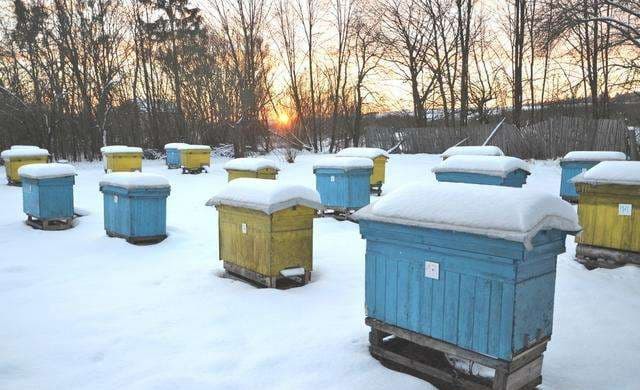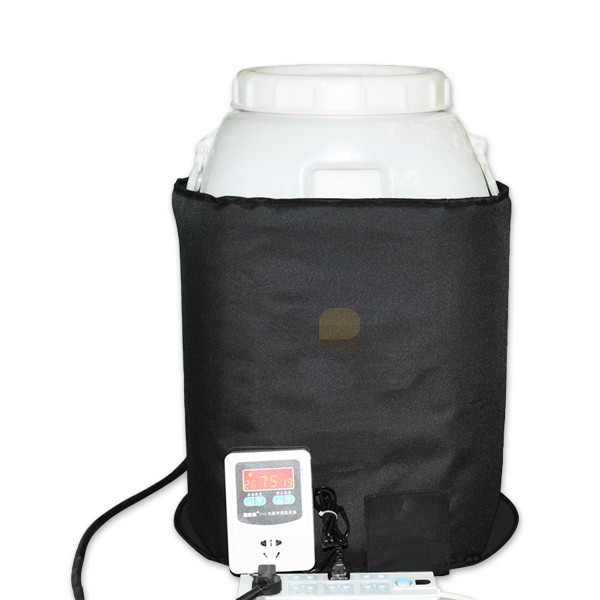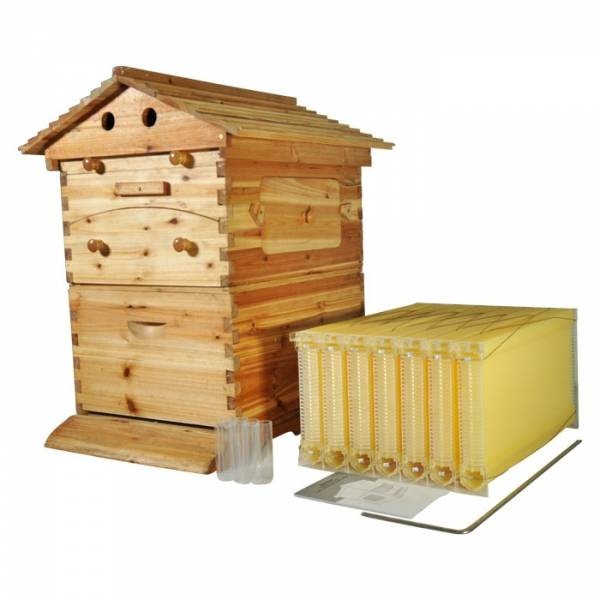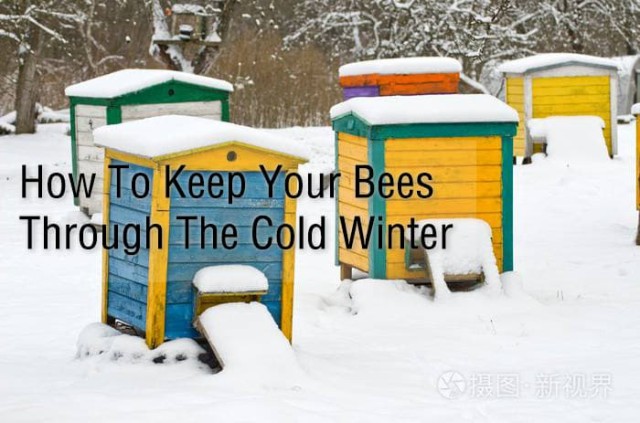Insects don't have the luxury of being able to put on a coat or build a fire when the temperature drops, so they have to rely on their own natural mechanisms to get them through the winter. For honeybees, this means huddling together in a big group to generate warmth. The bees at the center of the group will vibrate their flight muscles to create heat, and the bees on the outer edge of the group will rotate so that everyone gets a chance to be in the warm center.
Even if temperatures are freezing, honeybees can survive some pretty extreme temperatures and survive until spring comes. They do this by forming a "winter cluster" in their hive. The bees in the cluster will vibrate their wing muscles to generate heat, which in turn keeps the entire cluster warm.
Bees are one of the most amazing creatures on the planet. They have the ability to survive in cold weather conditions that would kill most other insects. While we don’t see bees flying around during the winter, they are working hard to stay warm. Their amazing survival instincts allow them to keep the hive alive and produce honey even in the harshest conditions.
Bees are pretty amazing creatures and have developed a number of strategies to help them survive the winter months. Some bees will cluster together to keep warm, while others will fly south to find warmer climates. Still other bees will die off, leaving the colony to be led by a new queen come spring. No matter what strategy they use, bees are sure to be busy all winter long!
Bees are hardworking creatures who do not slow down when the cold weather rolls around. In fact, they actually work harder to ensure that the hive has enough honey to last the winter. While they are out gathering nectar, they also keep an eye out for any signs of trouble. If they see a predator or something that could harm the hive, they will use their stingers to defend it.
Bees are creatures that work hard day and night to ensure the survival of their colony. Instead of spending their time collecting nectar and making honey, they dedicate themselves to keeping the nest warm enough to live. This is an admirable quality, as it shows that bees are willing to sacrifice their own needs for the good of the group.
Bees are vital to the ecosystem and the survival of many plants and animals. Without bees, these plants and animals would not be able to reproduce and would eventually die off. bees go into a state of semi-hibernation in order to conserve energy and preserve food supplies in winter. This helps them to survive the cold months when there is not as much food available.
During the winter, the colony only needs to heat the brood (developing bees) which stays in their safe, warm environment as they hibernate. The bees will prevent the drafty outside air from entering the hive by capping the cells with wax. The colony will cluster around the queen to keep her warm and will rotate positions so that each bee gets a turn in the warmth.
What Do Bees Do During The Winter?
When temperatures start to drop, bees will form a winter cluster to stay warm. The cluster is made up of bees huddled together in a tight ball with the queen bee in the center. Their body heat and the movement of their wings helps to keep the cluster warm. During the winter, bees will only leave the cluster to relieve themselves or if the hive is in danger of running out of food.

Bees are able to stay warm during the winter by working together. They huddle together inside their hive and take turns being in the center of the group where it is warmer. By doing this, they are able to keep themselves, their queen, and their brood warm enough to survive the drop in temperature.
In fact, they don’t even make it for themselves. Bees make honey to feed their young and to keep the hive going through the winter. We may think that bees make honey for us to drizzle over our biscuits and pancakes, but I’m sorry to say, they don’t. In fact, they don’t even make it for themselves. Bees make honey to feed their young and to keep the hive going through the winter. The honey we eat is just a by-product of their hard work.
Bees are one of the most important creatures on the planet, and they work hard to make sure that they can survive the winter. They work day in and day out during the spring and summer, foraging your neighbor flowers for nectar so they can eat it during the winter. Without bees, we would not have many of the things that we rely on for our survival, and so it is important to do what we can to help them.
Honeybees are able to store away enough honey to survive the cold weather. This is because there usually isn’t much blooming during the winter, so the bees have to make sure they have enough honey to last them until spring.
During the winter, the lack of natural forage in the environment significantly decreases, and beekeepers refer to this as a nectar or honey dearth. While this can be a challenging time for beekeepers, there are steps that can be taken to help the bees through this period, such as providing them with supplemental feedings.
A nectar flow can last for just a few days or a couple of weeks. Bees are amazing creatures. Not only do they produce honey, but they also help to pollinate flowers and plants. During a nectar flow, bees collect nectar from flowers and store it in their hives. This nectar is like money in the bank for the bees, as they can use it to eat when it is too cold to fly. A nectar flow can last for just a few days or a couple of weeks, making it an important time for bees.
As winter approaches, bees know they need to eat more to keep their energy levels up. But they aren’t just eating inside the colony; their real goal is to keep the queen and her eggs and brood warm. To do this, they cluster together tightly, vibrating their wing muscles to generate heat. The bees on the outside of the cluster rotate to the inside, so that every bee gets a turn at being in the warmth.
During the winter, the queen slows down her egg-laying to make the job easier. However, she and the other bees still have to work hard all winter long. They do this until the temperature warms up enough for flowers to bloom and day-time highs to relieve the bees of this responsibility.
How Do Bees Keep Their Nest Warm?
Honeybees are cavity dwellers who help their colony to survive the winter easier. By creating a wax lining in their hive, they are able to insulate it and keep the heat in. This helps to keep the hive at a consistent temperature, which is important for the bees' survival.
But in the winter, when there are no flowers blooming and very little nectar or pollen available, the bees have to work hard to keep their hive warm enough to prevent their food stores from freezing.
The temperature of the brood area is critical to the proper development of larvae and pupaeBees are able to regulate the temperature of their nests by fanning their wings to circulate air and by clustering together. The temperature of the brood area is critical to the proper development of larvae and pupae, so bees will make sure to keep this area well- insulated. By doing this, bees can save a lot of energy that would otherwise be spent on heating the entire nest.
Bees need to heat any eggs the queen has been laying until the bee hatches out. The amount of heat required depends on the species of bee. For example, bumblebees incubate their eggs at about 93 degrees Fahrenheit, while honeybees keep their eggs at a toasty 99.5 degrees.
By vibrating their wing muscles, they generate enough heat to keep the hive at a consistent temperature Bees are not only hard workers, but they are also smart when it comes to keeping themselves and their queen warm. Instead of simply throwing on another coat, bees vibrate their wing muscles to generate heat and keep the hive at a consistent temperature. This fascinating trait is just another example of the many ways that bees are amazing creatures.
The outer bees are working to keep the cluster warm, but as they get tired, they move to the center of the cluster where it is warmer and rest.
For now, let’s just say that it can be pretty uncomfortable for them. As the temperature drops, bees have to group together more tightly in order to keep warm. This can have some negative side effects, such as decreased airflow and less access to food. Additionally, it can be quite uncomfortable for the bees.
Bees consume honey to give them the energy to vibrate their wings. This enables them to fly and collect pollen from flowers. Without honey, bees would not have the necessary energy to fly and pollinate plants.
The process is called thermoregulation and it’s how some animals, like ground squirrels, survive freezing winters. They actually climb inside empty cells like it’s a sleeping bag to help concentrate heat. Then, when their bodies are warm enough, they go into a state of hibernation where their heart rate and breathing slow way down.
How Do Bees Go To The Bathroom?
Just like humans, bees consume water and honey, and they excrete it as urine. Except, their urine is not yellow like ours. Instead, it’s clear and runny.Have you ever noticed a bee buzzing around your head and wondered what it was doing? Well, it might have been trying to tell you something. Believe it or not, bees actually need to relieve themselves. It’s not really noticeable during the spring and summer, but bees do have to go to the bathroom. Just like humans, bees consume water and honey, and they excrete it as urine. Except, their urine is not yellow like ours. Instead, it’s clear and runny. So, the next time you see a bee buzzing around, remember that it’s just trying to do its business.
Bees make a great contribution to the environment by pollinating plants. They don’t exactly have a bathroom; they go while they are flying. Beekeepers call this a “cleansing flight.” How delightful does that sound? Well, it’s not so delightful if you have a white car parked near a beehive. Little yellow streaks will start to appear on the car, and your nice BMW will turn into just a BM.
Bees are very clean creatures and they like to keep their house clean. However, if they can't fly, they will relieve themselves in the hive.
These yellow streaks are made by the honey bees as they travel to and from the hive. They are called pheromone trails and help the bees communicate where they have been and where they are going.
Checking In The Hive
While there are things a beekeeper can do to help a colony survive the winter, it’s best to just let them be.During the cold weather, many beekeepers worry about their colonies and whether or not they are still alive. However, opening the hive to check on the bees can actually be harmful and even kill them. There are ways to help a colony survive the winter, but the best thing a beekeeper can do is to leave them alone.
If you're a beekeeper, it's important to check on the status of your colony during a cold front or freezing temperatures. The hive needs to stay closed in order to keep the bees warm, but there are a few things you can do to make sure everything is okay. Checking the frames and making sure there's enough honey are two things you can do. You can also check the entrance to make sure there aren't any bees trying to get out.
A thermal camera is a highly specialized camera that can detect very small levels of heat. When used to inspect a beehive, the thermal camera can help beekeepers to identify areas of the hive that are warmer than others. This can be an indication of a problem, such as a wax moth infestation, or simply a sign that the hive is healthy and active.
If the hive has snow on it and the colony perspires, the heat will actually melt some of the snow above the hole in the inner cover on the outside of the hive. You’ll see a circle of melted snow on the top of the hive.
If you see dead bees around the outside of a hive, it's a good sign that the bees are cleaning the colony. This is because they are able to see the bees in the snow and know that they need to be removed.
What Do Beekeepers Do In The Winter
Beekeepers often find themselves in a difficult position when it comes to the care of their bees. While it is the beekeeper's responsibility to ensure the health and well-being of their bees, it can be difficult to do so when faced with the numerous challenges that bees face on a daily basis. From pests and diseases to the ever-changing weather, beekeepers must constantly be on the lookout for anything that could potentially harm their bees. This can be a difficult and time-consuming task, but it is one that is essential in order to keep the bees healthy and productive.
We are placing our bees in artificial hives that are only 3/4-inch thick instead of inside a thick tree trunk. This is because the bees need a certain amount of space to build their honeycomb. If we put them in a thicker hive, they would not have enough room to build their comb and would be less likely to produce honey.
The good news is that bees are pretty good at taking care of themselves during the winter. The bees will huddle together in their hive to keep warm and will take turns going to the bathroom so that they don't have to go outside in the cold. They will also eat honey to give them energy.
Adding insulation to the outside of beehives is a common practice among northern beekeepers. This helps to make life a little easier for the bees during the winter.
Most beekeepers in the south don't need to do anything besides making sure there aren't drafty holes in their equipment that let cold air or, worse, water in. They also need to provide their hives with good ventilation so the bees can regulate the temperature inside. In the winter, bees cluster together to keep warm, and if the hive is too small or too tightly sealed, they can suffocate.
What Can A Beekeeper Do To Help Their Bees?
Beekeepers are always looking for ways to help their bees. They may add new plants to their gardens that attract bees or build houses for them to live in. Some beekeepers even keep honeybees in their backyards!
Many beekeepers take extra measures to keep their colonies warm during the winter. This is because bees are more likely to die from the cold than from any other factor. By taking steps to keep the hive warm, beekeepers can help ensure that their bees will survive the winter.
Honey bees are critical for the pollination of many fruits, vegetables, and other plants. In the United States, beekeepers play a vital role in ensuring a healthy crop yield. To maintain a strong and vibrant hive, beekeepers will do everything from placing light bulbs in their hives to bringing the hives inside a building to keep it warm. Without the dedication of these hardworking individuals, our agricultural industry would suffer greatly.
Here are a few things beekeepers can do to help their colonies survive the winter:If you find any cracks or openings in your beehive, it's important to seal them up quickly. Duct tape is a great option for this, as it will create a water-tight seal. This is especially important in the winter, as bees are very sensitive to drafts. By sealing up any cracks or openings, you'll help your bees stay warm and dry all winter long.
A mouse guard is a small, wire mesh screen that is placed over the entrance to a home or other structure. The purpose of a mouse guard is to keep mice from entering the home and nesting there. Mouse guards are especially important in the winter, when mice are looking for warm places to live.
If you have beehives near a body of water, it's important to take measures to prevent the wind from blowing onto the hives and chilling the bees. One way to do this is to build a windbreak, which can be as simple as a row of bushes or a fence.
In extremely cold areas, wrapping a colony with some insulation can help. In the south, this isn’t necessary.
If necessary, feed bees dry sugar or fondant instead of liquid syrup during the winter. The syrup adds a lot of humidity to the inside of the hive. The bees will use the sugar or fondant to make their own honey.
Close The Screened Bottom Board During Winter?
Well, in the winter you have a few options. The first is to simply not use the screened bottom panel at all and just go with a solid bottom. The other option is to put something over the screen to keep the elements out. The screened bottom panel is the most popular type of bottom board used for beehives. The screen allows air and debris to pass through, which is excellent during the spring, summer, and fall. However, in the winter, the screen can let elements into the hive. To avoid this, the panel can be covered with something to keep the elements out.
One of the biggest dangers to bees during the winter is moisture. If there is too much humidity in the colony, it can kill the bees. This is why it is so important to make sure that the hive is well-ventilated and that the bees have access to plenty of dry, sugar-rich food.
The bees may have to clean up any of the bees that died during the cold front. This is because the bees that died during the cold front may have been unable to hold their urine in, and so it may have leaked out onto the ground. If this happens, the bees may have to clean up the mess to prevent the spread of disease.
The worker bees are constantly flying in and out of the nest, collecting pollen and nectar to feed the larvae. They also keep the hive clean and do any necessary repairs.Bees are amazing creatures! Not only do they work tirelessly to collect pollen and nectar to feed the larvae, but they also keep the hive clean and do any necessary repairs. Their hard work ensures that the queen can lay all those eggs during the winter, which are the next generation of worker bees. Thanks to the bees, we can enjoy the fruits of their labor!
This can be a problem because the workers will not be able to take care of all of the eggs and some will not survive. The queen will need to be careful not to lay too many eggs or the colony will not be able to survive.
During the winter, the queen actually restricts the number of eggs she lays. However, she ramps back up in the late winter early spring. By doing this, there are plenty of worker bees to make the most of the spring bloom.
If there is a lack of adult bees to keep the eggs and larva warm, the brood on the edges will die. This is because the temperature needs to be kept at a certain level for the eggs and larva to survive and if there aren't enough bees to generate heat, the ones on the edges will perish.
During a cold front, the bees cannot clean out their hive, so the "chores" have started to pile up. This can lead to a decrease in the honey production and an increase in the number of bees that die.
Honeybees are incredible creatures. Not only do they produce delicious honey, but they also keep a very clean interior hive. They work hard to keep it that way by constantly cleaning it out. Because of this, beekeepers should expect to see more dead bees just outside the front of their colony. While it may be disheartening to see all those dead bees, it's actually a good sign that the hive is healthy and the bees are doing their job.
If the cold front was particularly late in winter, depending on your climate, this could be February through April; you'll see signs of the chilled brood. This is pretty easy to identify because, in addition to seeing dead adults in front of the colony, you'll also see dead white bee larva in the front too. If you find that your colony has chilled brood, there’s not much you can do besides wait it out. The colony will likely rebound on its own as the weather warms up and they can start to rear new brood.
Winter Beekeeping Tools
Honey Bucket Heater, Bee Blanket, Honey Blanket, Honey Bucket Warmer
There is 50L crystalline honey in the barrel.It melted in 16 hours (the melting time varies according to the type of honey, the surrounding temperature and environment), stirring once every hour can speed up the honey melting.

Auto Flow Beehive Wholesale
The Auto Flow Beehive is a revolutionary new beehive that allows honeybees to flow continuously, without the need for human intervention. This means that honey can be harvested on a regular basis without disturbing the bees, which is crucial for their health and wellbeing. The hive is also designed to be more user-friendly, with an easy-to-use interface that makes it perfect for beginner beekeepers.


